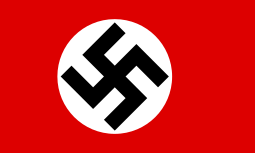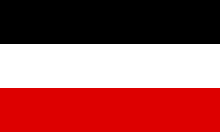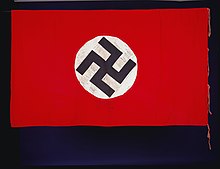Flag of Nazi Germany
This article needs additional citations for verification. (November 2019) |
 | |
| Name | Nazi flag, Swastika flag |
|---|---|
| Use | National flag and ensign |
| Proportion | 3:5 |
| Adopted | 1935 |
| Relinquished | 1945 |
| Design | A horizontal red flag with a black swastika on a white circle |
The flag of Nazi Germany, officially the flag of the German Reich, featured a red background with a swastika on a white disc. This flag came into use initially as the banner of the Nazi Party (NSDAP) after its foundation. Following the appointment of Adolf Hitler as Chancellor in 1933, this flag was adopted as one of the nation's dual national flags, the other being the black-white-red horizontal tricolour of the German Empire.
This dual flag arrangement was ended on 15 September 1935, one year after the death of Reich President Paul von Hindenburg, and the Nazi flag became the only national flag of Germany. One reason for the change may have been the "Bremen incident" of 26 July 1935, in which a group of demonstrators in New York City boarded the ocean liner SS Bremen, tore the Nazi Party flag from the jackstaff, and tossed it into the Hudson River. When the German ambassador protested, US officials responded that the German national flag had not been harmed, only a political party symbol.[1] The new flag law was announced at the annual party rally in Nuremberg in 1935,[2] where Hermann Göring claimed the old black-white-red flag, while honoured, was the symbol of a bygone era and under threat of being used by "reactionaries".[3]
History[]
Origins[]

After rejecting many suggestions and colours, the process of choosing a new flag was described by Hitler as follows:
"I myself, meanwhile, after innumerable attempts, had laid down a final form; a flag with a red background, a white disk, and a black swastika in the middle. After long trials I also found a definite proportion between the size of the flag and the size of the white disk, as well as the shape and thickness of the swastika."
— Adolf Hitler, Mein Kampf (1925)
After Hitler was appointed Chancellor of Germany on 30 January 1933, the black-red-gold tricolour flag was discarded; a ruling on 12 March established two legal national flags: the reintroduced black-white-red imperial tricolour and the flag of the Nazi Party.[4][5]
Nazi ensigns had a through and through image, so the "left-facing" and "right-facing" version were each present on one side. However, the Nazi flag on land was right-facing on both sides.[a]
Albert Speer, in his book Inside the Third Reich, stated that: "in only two other designs did he (Adolf Hitler) execute the same care as he did his Obersalzberg house: that of the Reich War Flag and his own standard of Chief of State", showing that Hitler was an avid vexillographer (flag designer).
An off-centred disk version of the swastika flag was used as the civil ensign on German-registered civilian ships and was used as the Jack on Kriegsmarine warships. There is debate as to whether the off-centred disk flag was the official national flag from 1935 to 1945, such as at the popular vexillogy site, Flags of the World.[7] References from Third Reich books that display the country's flags always show the centred-disk version as Germany's national flag. One book published by the Third Reich in 1937, Du bist Sofort im Bilde ('You Are Informed Immediately', a guide book to the organization of the Third Reich) displays a centred-disk German flag as Germany's national flag.[8] A book published one year earlier in 1936 in the Third Reich, Deutscher Beamten-Kalender 1936 ('German Civil Servants Yearbook 1936') also displays the centred-disk flag as the national flag, beside it the off-centred disk flag is described for use on a "Kriegsschiff" (warship).[9] Also the centred-disk flag was commonly used by civilians and the German armed forces aside from the navy.

From 1933 to at least 1938 in Nazi Germany, before any official swastika flag went into use, it had to be put into a ceremony where it touched the "Blutfahne" or Blood flag,[citation needed] the swastika flag used by Nazi paramilitaries during the failed Beer Hall Putsch in 1923. This lengthy ceremony took place at every Nuremberg Rally. It is unknown whether this tradition was continued after the last Nuremberg rally in 1938.[citation needed]
Symbolism[]
The Nazi flag takes its colours from the imperial tricolour, with Hitler writing that he "was always for keeping the old colours," because he saw them as his "most sacred possession" as a soldier, and also because they suited his personal taste.[10] Hitler added new symbolism to the colours, stating that "[t]he red expressed the social thought underlying the movement. White the national thought," and that the black swastika was an emblem of the "Aryan race" and "the ideal of creative work which is in itself and always will be anti-Semitic."[10]
Since 1945[]

At the end of World War II, after the fall of the Third Reich, the first law enacted by the Allied Control Council abolished all symbols and repealed all relevant laws of the Reich.[11] The possession of swastika flags has been forbidden in several countries since then, with the importation or display of them forbidden particularly in Germany.
Today, the Nazi flag remains in common use by neo-Nazi supporters and sympathisers.
See also[]
- Flag of Germany
- List of German flags
- List of flags of the Wehrmacht and Heer (1933–1945)
- List of flags of the Luftwaffe (1933–1945)
- List of flags of the German Navy (1935–1945)
Notes[]
References[]
- ^ Brian Leigh Davis: Flags & standards of the Third Reich, Macdonald & Jane's, London 1975, ISBN 0-356-04879-9
- ^ GERMANY: Little Man, Big Doings, TIME Magazine, 23 September 1935
- ^ Statement by Hermann Göring, quoted in the Völkischer Beobachter (17 September 1935) (in German)
- ^ von Hindenburg, Paul (12 March 1933). "Erlaß des Reichspräsidenten über die vorläufige Regelung der Flaggenhissung" [Decree of the President for the provisional regulation of raising flags]. documentArchiv.de (in German). Retrieved 17 July 2010.
- ^ Fornax. "The German Swastika Flag 1933–1945". Historical flags of our ancestors. Retrieved 17 July 2010.
- ^ "Centred vs. Offset Disc and Swastika 1933-1945 (Germany)".
- ^ http://www.flags-of-the-world.net/flags/de1933_o.html
- ^ "Premier Source of Third Reich Memorabilia & Nazi Lit | OD43". 8 February 2021.
- ^ "Premier Source of Third Reich Memorabilia & Nazi Lit | OD43". 8 February 2021.
- ^ Jump up to: a b Mein Kampf at Project Gutenberg
- ^ Allied Control Council (30 August 1945). "Law N° 1 from the Control Council for Germany: Repealing of Nazi Laws". European Navigator. Retrieved 23 December 2007.
External links[]
- 1935 establishments in Germany
- 1945 disestablishments in Germany
- Flags introduced in 1935
- Flags of Nazi Germany
- Historical flags
- Obsolete national flags
- Swastika
